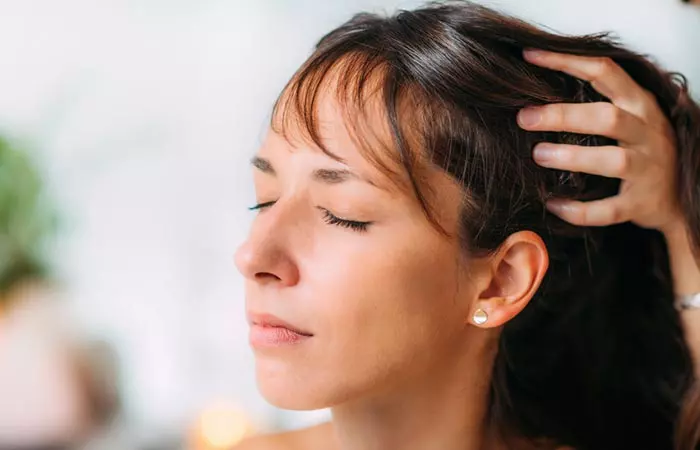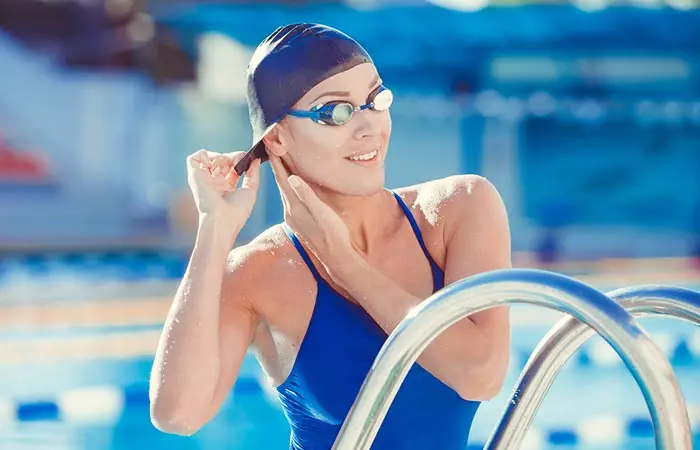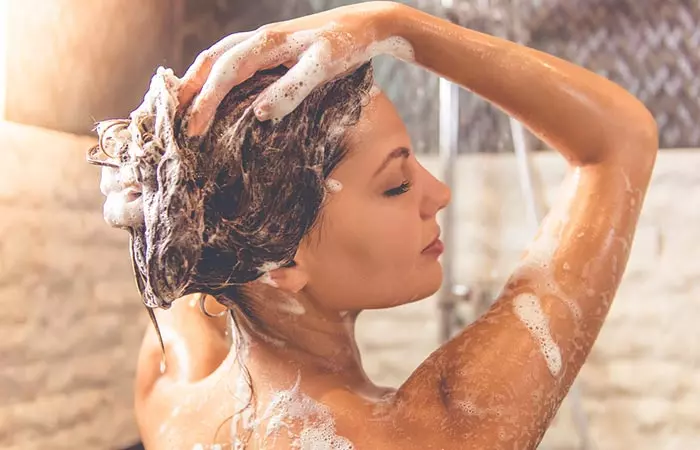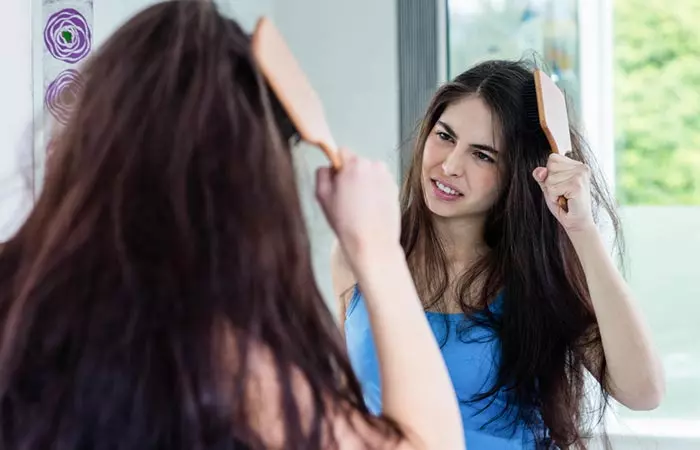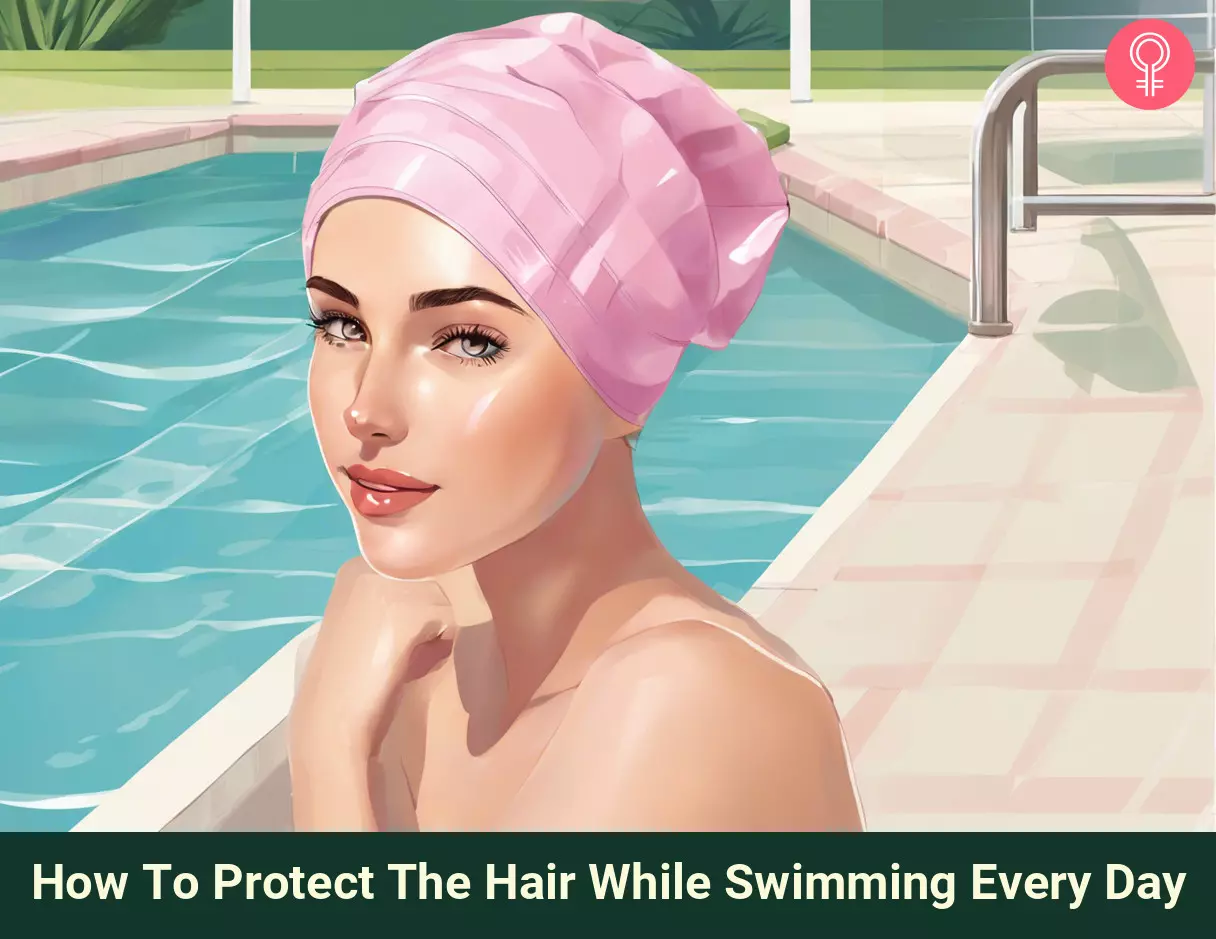Hair Care For Swimmers – Tips To Protect It From Chlorinated Water
Pre-Swimming Hair Care
Oil Your Hair
Oiling is the primary and most important step to protect the hair from chlorinated water. Oil penetrates the hair shaft, prevents water from entering into the cuticle, lowering the chances of hygral fatigue (swelling and drying of the cuticle). Oil can fill the gaps between the cuticle cells and prevent chlorine from entering into the cuticles (1). Applying a swimmer’s hair oil before swimming forms a protective layer on the hair and makes the hair waterproof. It also prevents leaching of hair color and keeps blonde color from turning green. Use coconut or olive oils to nourish and hydrate the hair during and after swimming. Applying coconut oil (rich in lauric acid) can help prevent protein loss caused by chlorine in the water and reduce further hair damage (2). Massage coconut oil gently onto the damp hair to protect it from chlorinated water. A study, conducted between October 2016-2017, showed that out of the 1899 individuals, 327 (17.2%) reported trying standardized scalp massages(SSM). Among them, 68.9% reported either stabilization of hair loss or regrowth.
Take A Quick Shower With Non-Chlorinated Water
Showering immediately post swimming can help prevent chlorinated water from penetrating the hair. Wetting hair with an oil coating absorbs less chlorine from the pool water, preventing hair damage. While we all think that we may know how to shower properly, following the right process and a few tricks can help keep your hair healthy and nail your shower routine.
Apply Leave-In Conditioner
A leave-in conditioner is a humectanti A widely used ingredient in hair products that helps to keep the tresses hydrated by drawing moisture from the environment. that protects the hair from chlorine water damage. It not only nourishes your hair but also forms a protective layer against chlorine and other harmful chemicals in the pool. A leave-in conditioner neutralizes the electrical negative charge of the hair fibers by adding positive charge and lubricates the hair cuticles, making them hydrophobic (waterproof) (1). It mimics the hair natural lipidi The fatty acid layer over the hair shaft that protects it from external damage, contributing to the health, strength, and luster of the hair. content, seals the cuticle, and minimizes frizz and breakage.
Spritz Some Hairspray
If you are into outdoor swimming, use an SPF hair spray for sun protection. A hairspray with botanical ingredients nourishes the hair and protects it from UVA and UVB sun damage. It also prevents the fading of hair color. You can also use a hat or a scarf when you are not in the water.
Hair Care While Swimming
Wear A Swimming Cap
Wearing a swimming cap or a hair wrap is probably the best way to protect the hair from the damage caused by chlorinated water. It covers the entire head, prevents contact with water, and keeps the hair dry. The interesting part is that it has a utilitarian and fashionable approach. You can protect the hair and also match the cap color with your swimwear. Note: If you are not comfortable with wearing a swimming cap, use a hair tie and make a bun on the top of the head and avoid dampening it as much as possible.
Wear Protective Hairstyles
If you swim daily, choose hairstyles that keep your hair secure and minimize tangling and damage from chlorine and water. Low buns, braids, twist braids, or high ponytails are good options to wear underneath the swim cap. You can also apply some protective gel to prevent the chlorine and water from damaging your tresses.
Choose Outdoor Pools
Swimming in outdoor pools is better for your hair than indoor pools because the chlorine evaporates more quickly into the air, lowering its concentration in the water. This may reduce the amount of chlorine that could be absorbed by your hair and skin, making it a healthier and better option when available. However, it’s not only about the hair. Paying attention to important skin care tips for swimmers also to ensure their skin remains healthy despite frequent exposure to chlorine and other pool chemicals. However, avoid swimming outdoors when it’s very sunny.
Post-Swimming Hair Care
Wash Your Hair Thoroughly
Rinse your hair immediately after swimming. It helps clear the buildup of chlorine and other harmful chemicals. A quick shower removes salt water (in case of outdoor swimming) and all the residue from the scalp. To safeguard your hair from chlorine damage, understanding what chlorine does to your hair can help you take preventive measures to keep your hair healthy and strong.
Shampoo Your Hair
Chlorine deposition is a disaster for your hair texture and color. Even saltwater bleaches blonde hair, making it dry and frizzy. The best way to rinse the buildup is by using an anti-chlorine shampoo or swimmer’s shampoo. It not only removes excess deposits from the hair and the scalp but also nourishes the tresses.
Apply A Deep Conditioner
A deep conditioner can fight dryness, moisturize, and nourish the hair. You can also apply a leave-in conditioner or swimmer’s conditioner for extra nourishment and shine. A deep conditioning mask or a swimmer’s hair mask is also a great option to restore nourishment. Anna, a beauty and lifestyle vlogger, recommends always taking a deep conditioner along and using it immediately after rinsing the hair after a swim. She states, “Allowing my hair to soak up some conditioner oil on my way home just makes it so much easier to detangle while I’m in the shower or after the shower. And it really helps to bring moisture back into my hair (i).”
Comb Your Tresses
Combing with a wide-toothed brush controls frizz and is an easy way to detangle your hair without pain. It loosens the tension built up in the hair and reduces breakage. There are certain things you should avoid in post-swimming hair care. Check out the following section to know more!
Things To Avoid In Post-Swimming Hair Care
Avoid Dryers Post-Swimming
Blow drying can damage the hair, making it more dehydrated. It is better to towel dry your hair and let it dry naturally.
Avoid Washing The Hair More Than Once A Day
Though shampooing the hair helps keep the scalp healthy and oil-free, doing it more than once a day might make your hair dry and brittle. Scroll down to find how chlorine and saltwater can damage the hair.
How Chlorine And Saltwater Damage The Hair
Chlorine water can turn the hair (and blonde hair) green. It reacts with hair keratin and forms water-soluble chemicals that bond with the hair fiber, resulting in hair breakage, dryness, and hair loss. The chlorine and the other chemicals in the pool strip the scalp’s natural oils and make the hair dry and frizzy. Regular exposure to chlorinated water increases the hair porosity and causes swelling of the scalp, leading to intense damage (1). Chlorine and saltwater affect color-treated hair. They dry out the hair and wick off natural oils from the scalp. A study on Japanese elite swimmers shows that hydrochloric acid in pool water penetrates deeply into the hair cortexi The middle layer of a hair shaft that imparts strength, shape, texture, and color to the hair fiber. . This leads to the oxidation and degeneration of melanosome (a pigment responsible for the hair color) (3). If your scalp is sensitive, chlorine may cause itchiness and scalp inflammation. How often should a swimmer wash their hair? Wondering how to keep your hair safe when swimming? Do not fear; we have mentioned everything in the infographic below. Check it out!Illustration: StyleCraze Design Team Swimmers need not wash their hair regularly. Washing the hair two to three times a week with a shampoo and conditioner can help remove the chlorine buildup. Can I go swimming if I dye my hair? Yes, you can go swimming if you have bleached or dyed your hair. Follow the tips mentioned in the article to prevent the hair color from fading. What is the best hairstyle for swimming? Braids, ponytails, and top knots are the best hairstyles for swimming as they decrease the contact area and protect the hair. You can use hair clips or a bandana to secure the front of your hair. Will swimming once a week damage my hair? The chlorine in the pool water can damage your hair, whether you go for a swim regularly or once a week. You can reduce the risk of damage by wearing a swim cap, deep conditioning your hair, or using hair sprays.
Illustration: How To Protect The Hair While Swimming Every Day
Learn how to take care of your hair and skin while swimming! Get tips on how to protect your hair and skin from chlorine and other pool chemicals in this video. Watch it now!
